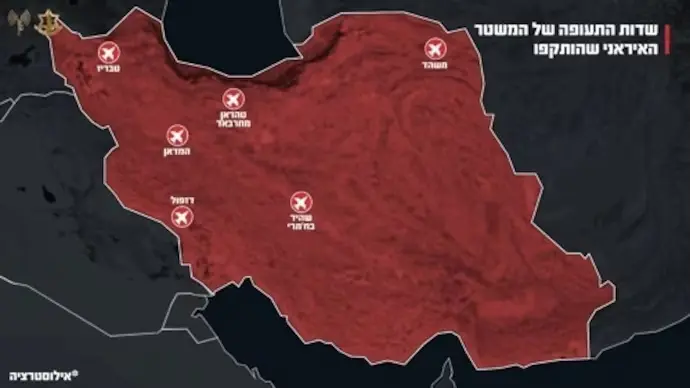
In a dramatic escalation, Israel has launched precision airstrikes on six Iranian military airports, destroying 15 fighter jets and helicopters
Precision and Power: Inside Israel’s Coordinated Assault
Firestorm in the Skies – On June 23, 2025, the Israel Defense Forces (IDF) executed a sweeping aerial campaign targeting six Iranian military airports across Tehran, Mashhad, Dezful, and other strategic regions. The operation, involving over 15 Israeli fighter jets, was aimed at neutralizing Iran’s aerial strike capabilities and disrupting its missile infrastructure.
Table of Contents
According to the IDF, the strikes destroyed 15 Iranian aircraft, including F-14s, F-5s, and AH-1 Cobra helicopters, along with a refuelling plane. Runways, underground bunkers, and missile storage sites were also decimated. The targeted bases were reportedly preparing for retaliatory strikes against Israeli territory following recent U.S. airstrikes on Iran’s nuclear facilities.
The IDF emphasized that the operation was both preemptive and defensive, designed to maintain air superiority and prevent further Iranian aggression. “This mission was guided by real-time intelligence and aimed at dismantling Iran’s offensive capabilities,” the IDF stated in a post on its official channel.
Aftershocks and Escalation: Regional Fallout Unfolds
The airstrikes mark a significant escalation in the already volatile Israel-Iran standoff. Just days earlier, Iran had launched a barrage of missiles targeting Israeli cities like Tel Aviv and Haifa, in response to U.S. strikes on its nuclear sites at Fordow, Natanz, and Isfahan.
Iran has yet to officially confirm the extent of the damage, but reports suggest that at least 10 members of the Islamic Revolutionary Guard Corps (IRGC) were killed in a separate Israeli strike on Yazd province. Meanwhile, an Israeli drone was reportedly shot down over Khorramabad, though the IDF assured there was no risk of data compromise.
The international community is watching with growing alarm. The Strait of Hormuz, a vital artery for global oil shipments, remains a potential flashpoint. Iran has threatened to close the strait in retaliation, a move that could send oil prices soaring and disrupt global supply chains.
Strategic Implications: What Lies Ahead for the Region
This latest exchange underscores a dangerous new phase in Middle East geopolitics. With both Israel and Iran demonstrating advanced strike capabilities and a willingness to escalate, the risk of a broader regional conflict looms large.
Military analysts suggest that Israel’s strikes were not just tactical but strategically symbolic, a message to Tehran and its allies that Israeli air dominance remains unchallenged. The destruction of aircraft and missile sites significantly weakens Iran’s immediate retaliatory options, but it may also provoke asymmetric responses, including cyberattacks or proxy warfare.
For global powers, the situation presents a diplomatic tightrope. The U.S., having already struck Iranian nuclear facilities, now faces pressure to de-escalate while reaffirming its support for Israel. Meanwhile, Russia and China have called for restraint, warning that continued hostilities could destabilize the entire region.
In the coming days, all eyes will be on Iran’s next move. Will it retaliate directly, escalate through proxies, or seek diplomatic channels? Whatever the path, one thing is clear: the Middle East is on edge, and the consequences of this confrontation will reverberate far beyond its borders.
Stay updated with the latest news on Rapido Updates. Keep yourself updated with The World, India News, Entertainment, Market, Automobile, Gadgets, Sports, and many more
Missiles and Meltdown: Iran Strikes Israel as Arak Reactor Bombed in Escalating War